Navigation
Underwater Camera Rig Built by Students and Teacher Deployed to Observe Antarctic Fish
- Antarctic Circumpolar Current
- Antarctica
- Chicago
- Icefish
- Lights Camera Action
- Lindblom Math and Science Academy
- LLC
- Lockheed Martin Corp
- marine engineers
- National Science Foundation
- NSF
- NSF/PolarTREC
- Remotely Operated Vehicles
- Southern Ocean
- students
- teacher
- Underwater camera
- US
- Biodiversity
- Global Climate Change
- Oceans, Coral Reefs
The icy Southern Ocean that surrounds Antarctica is about as cold, stormy and inhospitable a body of water as can be imagined. But thanks to the ingenuity of a group of high-school students, their teacher and a miniature video camera on a cable, it has also become a real-life classroom for budding marine engineers.
Video taken by the Fish Spy camera and stock footage of NSF's Palmer Station in Antarctica. Courtesy of Paula Dell/NSF/PolarTREC
The icy Southern Ocean that surrounds Antarctica is about as cold, stormy and inhospitable a body of water as can be imagined. But thanks to the ingenuity of a group of high-school students, their teacher and a miniature video camera on a cable, it has also become a real-life classroom for budding marine engineers.
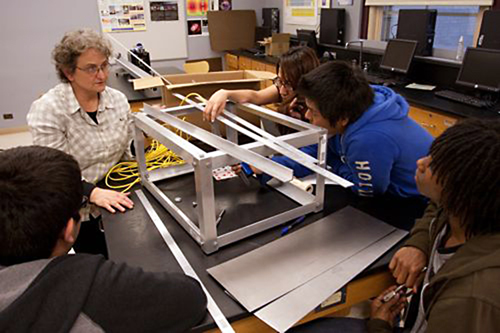 Paula Dell with the Fish Spy and her students, from left to right:: Miguel Limon, Liliana Diaz, Francisco Flores, and Raymond Thicklin. Photograph courtesy of Paula Dell, PolarTREC
Paula Dell with the Fish Spy and her students, from left to right:: Miguel Limon, Liliana Diaz, Francisco Flores, and Raymond Thicklin. Photograph courtesy of Paula Dell, PolarTREC
Using a camera and cable donated by an Arizona company whose owner has a keen interest in marine education, four students at Lindblom Math and Science Academy in Chicago, built an underwater device that braved the waters--off the National Science Foundation's (NSF) Palmer Station near the Antarctic Peninsula--to bring back video of the habitat of Antarctic fish.
Palmer is one of three year-round research stations that NSF operates as manager of the U.S. Antarctic Program.
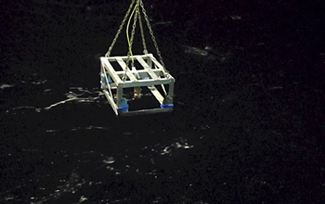 The Fish Spy rig is shown over the ocean.: Courtesy of Paula Dell/NSF/PolarTRECThe Fish Spy, as the teacher-student team dubbed it, was deployed in late June by Paula Dell, a teacher at Lindblom, a high school in Chicago's West Englewood neighborhood.
The Fish Spy rig is shown over the ocean.: Courtesy of Paula Dell/NSF/PolarTRECThe Fish Spy, as the teacher-student team dubbed it, was deployed in late June by Paula Dell, a teacher at Lindblom, a high school in Chicago's West Englewood neighborhood.
Dell deployed to Antarctica as part of the NSF-funded Polar Teachers and Educators Exploring and Collaborating (PolarTREC) program. PolarTREC is administered by the Arctic Research Consortium of the United States.
Fish Spy is comprised of a metal cage enclosing a video camera that Dell envisioned being dragged behind research vessels through the ocean on a long cable to keep an electronic eye on the creatures below the surface.
Dell's students had been designing and building Remotely Operated Vehicles for regional competitions for many years. So it was only natural for NSF-funded researchers Kristin O'Brien, with the University of Alaska Fairbanks, and Elizabeth Crockett from Ohio University to suggest that Dell's students build something that could be "towed behind the ship to learn something about the habitat of the animals we study."
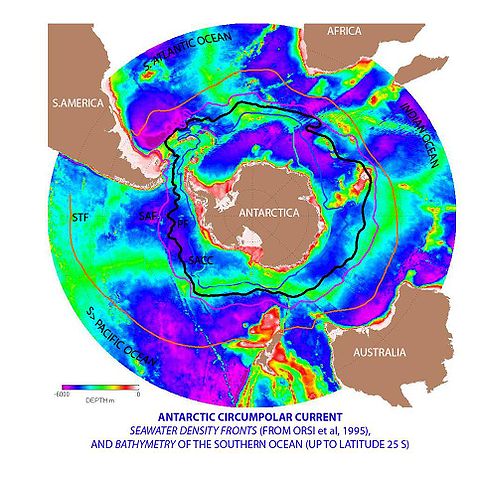 Antarctic Circumpolar Current
Antarctic Circumpolar Current
O'Brien and Crockett, who collaborate with Dell as part of PolarTREC, study several species of fish that are uniquely adapted to life in the extreme conditions of the Southern Ocean, which is isolated from other oceans by the Antarctic Circumpolar Current. Southern Ocean temperatures hover at or near -1.8 degrees Celsius (28.76 degrees Fahrenheit), and the water is rich in oxygen.
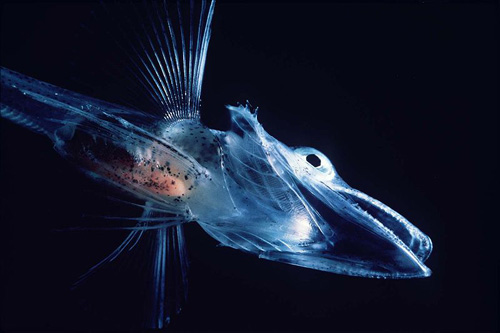 An icefish off the coast of Antarctica.: The Antarctic icefish belong to the perciform suborder Notothenioidei and are the largely endemic, dominant fish taxa in the cold continental shelf waters surrounding Antarctica. Photograph courtesy of Wikipedia
An icefish off the coast of Antarctica.: The Antarctic icefish belong to the perciform suborder Notothenioidei and are the largely endemic, dominant fish taxa in the cold continental shelf waters surrounding Antarctica. Photograph courtesy of Wikipedia
The so-called icefish have evolved many physiological traits that enable them to survive in their ecological niche. Like most other Antarctic fishes, they lack a swim bladder and have antifreeze proteins that keep their blood from freezing. But what sets them apart from all other vertebrates and other Antarctic fishes is their lack of the circulating oxygen-binding protein, hemoglobin.
The loss of hemoglobin is considered a neutral genetic mutation, one that neither enhances nor reduces fitness. But researchers hypothesize the loss of hemoglobin may be an evolutionary advantage because hemoglobin promotes the formation of free radicals that damage cells.
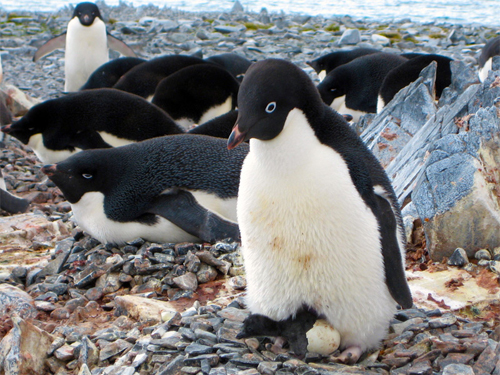 The Torgersen Island Penguin Camera The Penguin Camera is located on Torgersen Island (64°46’S, 64°04’W),: off the coast of Anvers Island and less than a mile from Palmer Station. Torgersen Island is home to a colony of Adélie penguins numbering approximately 2,500. This camera is seasonal and operates primarily from October to February, the Adélie breeding season. The camera is solar-powered and may sometimes experience brief outages due to inclement weather. Image and text courtesy of United States Antarctic Program
The Torgersen Island Penguin Camera The Penguin Camera is located on Torgersen Island (64°46’S, 64°04’W),: off the coast of Anvers Island and less than a mile from Palmer Station. Torgersen Island is home to a colony of Adélie penguins numbering approximately 2,500. This camera is seasonal and operates primarily from October to February, the Adélie breeding season. The camera is solar-powered and may sometimes experience brief outages due to inclement weather. Image and text courtesy of United States Antarctic Program
Rising to the challenge
So, rising to the challenge from the researchers, the students, Liliana Diaz, Francisco Flores, Miguel Limon and Raymond Thicklin, set to work designing, building and then refining their creation in the school swimming pool.
"They did a lot of research to decide what to make it out of and finally settled on aluminum," Dell said, noting that Campbell "Buzz" Scott, president of OceansWide, a non-profit ocean-education organization "was a great avenue for advice" on building the device.
The Fish Spy then was fitted with specialized video equipment donated to the project by Lights Camera Action, LLC, an underwater lighting and camera manufacturer in Arizona owned by Walter Ahland, who formerly served as a technology instructor in Illinois.
Lights Camera Action sponsors Marine Advanced Technology Education (MATE) competitions by providing underwater cameras at cost to schools, such as Dell's, that are involved in the MATE program.
"Lights Camera Action wants to acknowledge teachers like Paula who go beyond the classroom to bring real-life technology to students. Their recognition comes from the light in the students' eyes and the awareness by the students that 'someone cares,'" Ahland said. "With our sponsorship, we hope to enable schools to provide technology that instills a desire to learn for the students and also for the teachers."
He noted that sponsorship is available for all schools in the United States and Canada.
Working with Lights Camera Action, "we found this amazing little digital video recorder that fits in the palm of your hand," Dell said. "It allowed us to watch the action in real time and record it on a microSD card as well."
After a trial in the school pool, it was on to a more challenging environment.
"We deployed in Lake Michigan, which was really murky and you couldn't see anything, so we really [had] no idea how [it was] going to work," Dell said.
But by mid-June, Fish Spy was ready for its Antarctic sea trials, searching for underwater life after being launched from the deck of the Laurence M. Gould, an NSF-chartered, ice-strengthened research vessel.
However, to employ a catchphrase frequently heard in the Antarctic, "It's a Harsh Continent," with little respect for researchers' or a teacher's best intentions. The conditions aboard the Gould at sea, which challenge the stoutest ocean-going vessels, were just too rough for Fish Spy and prohibited the ship from safely seeking out shallower waters for a trial.
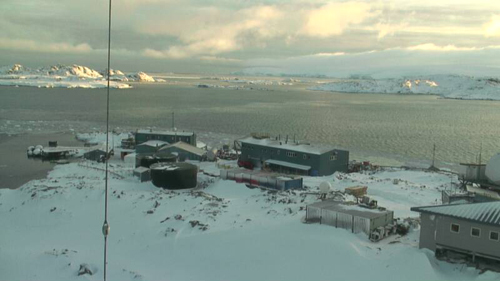 Located on Anvers Island near the Antarctic Peninsula, Palmer Station (64° 46’S, 64° 03’W) is named for Nathaniel B. Palmer,: who in 1820 on a sealing expedition in his 47-foot (14-meter) ship the Hero became the first American to record sighting Antarctica. The original station was built in 1965. In 1967, the U.S. Navy began construction of the current larger and more permanent station approximately a mile east of the original site. The first building at the new station, the biology laboratory, opened its doors to science in 1970. Today, two main buildings and several smaller structures make up Palmer Station and provide housing and research facilities for scientists and support personnel. Of the three U.S. Antarctic stations, Palmer is the only one that is accessed routinely during the winter. Ad The station supports science year-round and accommodates about 20 people in the winter and up to 44 in the austral summer. There are dormitory bedrooms, communal bathrooms, and a cafeteria-style kitchen. Everyone helps clean, and many participate in weekly science lectures and social events. Image and text courtesy of United States Antarctic Program
Located on Anvers Island near the Antarctic Peninsula, Palmer Station (64° 46’S, 64° 03’W) is named for Nathaniel B. Palmer,: who in 1820 on a sealing expedition in his 47-foot (14-meter) ship the Hero became the first American to record sighting Antarctica. The original station was built in 1965. In 1967, the U.S. Navy began construction of the current larger and more permanent station approximately a mile east of the original site. The first building at the new station, the biology laboratory, opened its doors to science in 1970. Today, two main buildings and several smaller structures make up Palmer Station and provide housing and research facilities for scientists and support personnel. Of the three U.S. Antarctic stations, Palmer is the only one that is accessed routinely during the winter. Ad The station supports science year-round and accommodates about 20 people in the winter and up to 44 in the austral summer. There are dormitory bedrooms, communal bathrooms, and a cafeteria-style kitchen. Everyone helps clean, and many participate in weekly science lectures and social events. Image and text courtesy of United States Antarctic Program
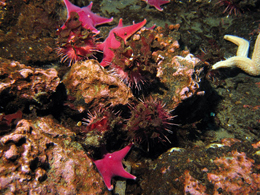 Sea stars and sea urchins are among the organisms found in abundance on the seafloor of McMurdo Sound.: Photograph courtesy of NSF by Andrew ThurberBut with assistance from marine technicians from Lockheed Martin Corp., NSF's Colorado-based Antarctic support contractor, Fish Spy was deployed from an inflatable Zodiac in the waters around Palmer Station, capturing not only images of Antarctic fish but other bottom-dwelling creatures such as limpets and sea stars, as well as shots of the underside of small icebergs, so called "bergy bits." Fish Spy also allowed a peek at the sunken wreck of the Bahia Paraiso, which ran aground in 1989, roughly two miles from Palmer Station.
Sea stars and sea urchins are among the organisms found in abundance on the seafloor of McMurdo Sound.: Photograph courtesy of NSF by Andrew ThurberBut with assistance from marine technicians from Lockheed Martin Corp., NSF's Colorado-based Antarctic support contractor, Fish Spy was deployed from an inflatable Zodiac in the waters around Palmer Station, capturing not only images of Antarctic fish but other bottom-dwelling creatures such as limpets and sea stars, as well as shots of the underside of small icebergs, so called "bergy bits." Fish Spy also allowed a peek at the sunken wreck of the Bahia Paraiso, which ran aground in 1989, roughly two miles from Palmer Station.
Although not accomplishing quite all that she or her students had hoped it would, Fish Spy became another in a suite of PolarTREC educational tools--from blog posts to pictures--that Dell used to widen her students' educational horizons.
"I've sent them an e-mail and let them know what's going on and put a short clip of the algae on the blog that shows them that the camera and their frame works," she said. "It's nothing huge, but I think the kids will be excited by the fact that they designed something that was actually deployed in the field and that functioned well. I think they will be excited to see the fish and other interesting things we caught on video."
This news is from The National Science Foundation (NSF) 10 July 2013 with additional images and text courtesy of United States Antarctic Program
Note Resources:
NSF - Division of Polar Programs
NSF in the Antarctic
Significant U.S. Science Discoveries from Antarctica
NSF Awards Database
U.S. Antarctic Program Science Summaries
The Antarctic Sun, Science Section
International Polar Year (IPY) 2007-2008
Search
Latest articles
Agriculture
- World Water Week: Healthy ecosystems essential to human health: from coronavirus to malnutrition Online session Wednesday 24 August 17:00-18:20
- World Water Week: Healthy ecosystems essential to human health: from coronavirus to malnutrition Online session Wednesday 24 August 17:00-18:20
Air Pollution
- "Water and Sanitation-Related Diseases and the Changing Environment: Challenges, Interventions, and Preventive Measures" Volume 2 Is Now Available
- Global Innovation Exchange Co-Created by Horizon International, USAID, Bill and Melinda Gates Foundation and Others
Biodiversity
- It is time for international mobilization against climate change
- World Water Week: Healthy ecosystems essential to human health: from coronavirus to malnutrition Online session Wednesday 24 August 17:00-18:20
Desertification
- World Water Week: Healthy ecosystems essential to human health: from coronavirus to malnutrition Online session Wednesday 24 August 17:00-18:20
- UN Food Systems Summit Receives Over 1,200 Ideas to Help Meet Sustainable Development Goals
Endangered Species
- Mangrove Action Project Collaborates to Restore and Preserve Mangrove Ecosystems
- Coral Research in Palau offers a “Glimmer of Hope”
Energy
- Global Innovation Exchange Co-Created by Horizon International, USAID, Bill and Melinda Gates Foundation and Others
- Wildlife Preservation in Southeast Nova Scotia
Exhibits
- Global Innovation Exchange Co-Created by Horizon International, USAID, Bill and Melinda Gates Foundation and Others
- Coral Reefs
Forests
- NASA Satellites Reveal Major Shifts in Global Freshwater Updated June 2020
- Global Innovation Exchange Co-Created by Horizon International, USAID, Bill and Melinda Gates Foundation and Others
Global Climate Change
- It is time for international mobilization against climate change
- It is time for international mobilization against climate change
Global Health
- World Water Week: Healthy ecosystems essential to human health: from coronavirus to malnutrition Online session Wednesday 24 August 17:00-18:20
- More than 400 schoolgirls, family and teachers rescued from Afghanistan by small coalition
Industry
- "Water and Sanitation-Related Diseases and the Changing Environment: Challenges, Interventions, and Preventive Measures" Volume 2 Is Now Available
- Global Innovation Exchange Co-Created by Horizon International, USAID, Bill and Melinda Gates Foundation and Others
Natural Disaster Relief
- STOP ATTACKS ON HEALTH CARE IN UKRAINE
- Global Innovation Exchange Co-Created by Horizon International, USAID, Bill and Melinda Gates Foundation and Others
News and Special Reports
- World Water Week: Healthy ecosystems essential to human health: from coronavirus to malnutrition Online session Wednesday 24 August 17:00-18:20
- STOP ATTACKS ON HEALTH CARE IN UKRAINE
Oceans, Coral Reefs
- World Water Week: Healthy ecosystems essential to human health: from coronavirus to malnutrition Online session Wednesday 24 August 17:00-18:20
- Mangrove Action Project Collaborates to Restore and Preserve Mangrove Ecosystems
Pollution
- Zakaria Ouedraogo of Burkina Faso Produces Film “Nzoue Fiyen: Water Not Drinkable”
- "Water and Sanitation-Related Diseases and the Changing Environment: Challenges, Interventions, and Preventive Measures" Volume 2 Is Now Available
Population
- "Water and Sanitation-Related Diseases and the Changing Environment: Challenges, Interventions, and Preventive Measures" Volume 2 Is Now Available
- "Water and Sanitation-Related Diseases and the Changing Environment: Challenges, Interventions, and Preventive Measures" Volume 2 Is Now Available
Public Health
- Honouring the visionary behind India’s sanitation revolution
- Honouring the visionary behind India’s sanitation revolution
Rivers
- World Water Week: Healthy ecosystems essential to human health: from coronavirus to malnutrition Online session Wednesday 24 August 17:00-18:20
- Mangrove Action Project Collaborates to Restore and Preserve Mangrove Ecosystems
Sanitation
- Honouring the visionary behind India’s sanitation revolution
- Honouring the visionary behind India’s sanitation revolution
Toxic Chemicals
- "Water and Sanitation-Related Diseases and the Changing Environment: Challenges, Interventions, and Preventive Measures" Volume 2 Is Now Available
- Actions to Prevent Polluted Drinking Water in the United States
Transportation
- "Water and Sanitation-Related Diseases and the Changing Environment: Challenges, Interventions, and Preventive Measures" Volume 2 Is Now Available
- Urbanization Provides Opportunities for Transition to a Green Economy, Says New Report
Waste Management
- Honouring the visionary behind India’s sanitation revolution
- Honouring the visionary behind India’s sanitation revolution
Water
- Honouring the visionary behind India’s sanitation revolution
- Honouring the visionary behind India’s sanitation revolution
Water and Sanitation
- Honouring the visionary behind India’s sanitation revolution
- Honouring the visionary behind India’s sanitation revolution

